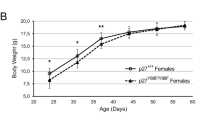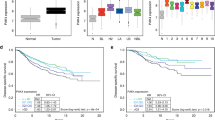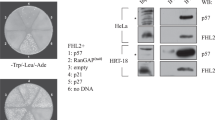Abstract
p18INK4c, a member of INK4 family of cyclin-dependent kinase inhibitors, negatively regulates the cyclin D-cyclin-dependent kinase 4/6 complexes which promote G1/S transition by phosphorylating the retinoblastoma tumor-suppressor gene product. Several recent studies using p18INK4c-null mice revealed that the p18INK4c plays an important role in cell proliferation and tumor development. We report here that 12-O-tetradecanoylphorbol-13-acetate (TPA), widely used as a protein kinase C (PKC) activator, suppresses the expression of p18INK4c through its promoter, accompanied by the induction of human cancer cell growth. Reduction of p18INK4c using small interfering RNA (siRNA) also enhanced cell growth, suggesting that p18INK4c is a critical target of TPA. Ro 31-8425, a potent and highly specific PKC inhibitor abrogated the suppressive effect of TPA on p18INK4c gene expression. However, the expression of dominant-negative c-Jun (TAM-67) did not inhibit the action of TPA on p18INK4c. These findings suggest that activation of PKC promotes human cancer cell growth through downregulation of p18INK4c in an AP-1 activation-independent manner. These results suggest that the accelerated cellular proliferation of some human tumors caused by enhanced PKC activity at least partially involves the suppression of p18INK4c, which is a ubiquitously expressed cyclin-dependent kinase inhibitor.
This is a preview of subscription content, access via your institution
Access options
Subscribe to this journal
Receive 50 print issues and online access
$259.00 per year
only $5.18 per issue
Buy this article
- Purchase on Springer Link
- Instant access to full article PDF
Prices may be subject to local taxes which are calculated during checkout




Similar content being viewed by others
References
Alvaro V, Touraine P, Raisman VR, Bai-Grenier F, Birman P and Joubert D . (1992). Int. J. Cancer, 50, 724–730.
Angel P and Karin M . (1991). Biochim. Biophys. Acta, 1072, 129–157.
Bai F, Pei X-H, Godfrey VL and Xiong Y . (2003). Mol. Cell. Biol., 23, 1269–1277.
Bit RA, Davis PD, Elliott LH, Harris W, Hill CH, Keech E, Kumar H, Lawton G, Maw A, Nixon JS, Vesey DR, Wadsworth J and Wilkinson SE . (1993). J. Med. Chem., 36, 21–29.
Brown PH, Chen TK and Birrer MJ . (1994). Oncogene, 9, 791–799.
da Rocha AB, Mans DR, Regner A and Schwartsmann G . (2002). Oncologist, 7, 17–33.
Franklin DS, Godfrey VL, Lee H, Kovalev GI, Schoonhoven R, Chen-Kiang S, Su L and Xiong Y . (1998). Genes Dev., 12, 2899–2911.
Goekjian PG and Jirousek MR . (2001). Expert Opin. Investig. Drugs, 10, 2117–2140.
Gordge PC, Hulme MJ, Clegg RA and Miller WR . (1996). Eur. J. Cancer, 32A, 2120–2126.
Guan KL, Jenkins CW, Li Y, Nichols MA, Wu X, O'Keefe CL, Matera AG and Xiong Y . (1994). Genes Dev., 15, 2939–2952.
Hannon GJ and Beach D . (1994). Nature, 371, 257–261.
Harper JW and Elledge SJ . (1996). Curr. Opin. Genet. Dev., 6, 56–64.
Hatta Y, Spirin K, Tasaka T, Morosetti R, Said JW, Yamada Y, Tomonaga M and Koeffler HP . (1997). Br. J. Haematol., 99, 665–667.
Kitagawa M, Higashi H, Jung HK, Suzuki-Takahashi I, Ikeda M, Tamai K, Kato J, Segawa K, Yoshida E, Nishimura S and Taya Y . (1996). EMBO J., 15, 7060–7069.
Krimpenfort P, Quon KC, Mooi WJ, Loonstra A and Berns A . (2001). Nature, 413, 83–86.
Latres E, Malumbres M, Sotillo R, Martin J, Ortega S, Martin-Caballero J, Flores JM, Cordon-Cardo C and Barbacid M . (2000). EMBO J., 19, 3496–3506.
Liebmann C . (2001). Cell Signal, 13, 777–785.
Miller CW, Aslo A, Campbell MJ, Kawamata N, Lampkin BC and Koeffler HP . (1996). Cancer Genet. Cytogenet., 86, 136–142.
Nishizuka Y . (1984). Nature, 308, 693–698.
Nishizuka Y . (1995). FASEB J., 9, 484–496.
O'Brian CA, Vogel VG, Singletary SE and Ward NE . (1989). Cancer Res., 49, 3215–3217.
Otsuki T, Jaffe ES, Wellman A, Kumar S, Condron KS and Raffeld M . (1996). Leukemia, 10, 356–360.
Ruas M and Peters G . (1998). Biochim. Biophys. Acta., 1378, F115–F177.
Rusin MR, Okamoto A, Chorazy M, Czyzewski K, Harasim J, Spillare EA, Hagiwara K, Hussain SP, Xiong Y, Demetrick DJ and Harris CC . (1996). Int. J. Cancer, 65, 734–739.
Schenk PW and Snaar-Jagalska BE . (1999). Biochim. Biophys. Acta., 1449, 1–24.
Serrano M, Lin AW, McCurrach ME, Beach D and Lowe SW . (1997). Cell, 88, 593–602.
Sharpless NE, Bardeesy N, Lee KH, Carrasco D, Castrillon DH, Aguirre AJ, Wu EA, Horner JW and DePinho RA . (2001). Nature, 413, 86–91.
Sherr CJ and Roberts JM . (1995). Genes Dev., 9, 1149–1163.
Sherr CJ and Roberts JM . (1999). Genes Dev., 13, 1501–1512.
Swannie HC and Kaye SB . (2002). Curr. Oncol. Rep., 4, 37–46.
Virchis A, Ganeshaguru K, Hart S, Jones D, Fletcher L, Wright F, Wickremasinghe R, Man A, Csermak K, Meyer T, Fabbro D, Champain K, Yap A, Prentice HG and Mehta A . (2002). Hematol. J., 3, 131–136.
Whyte P, Buchkovich KJ, Horowitz JM, Friend SH, Raybuck M, Weinberg RA and Harlow E . (1988). Nature, 14, 124–129.
Yamamoto H, Soh JW, Monden T, Klein MG, Zhang LM, Shirin H, Arber N, Tomita N, Schieren I, Stein CA and Weinstein IB . (1999). Clin. Cancer Res., 5, 1805–1815.
Zarkowska T and Mittnacht S . (1997). J. Biol. Chem., 272, 12738–12746.
Zindy F, Quelle DE, Roussel MF and Sherr CJ . (1997). Oncogene, 15, 203–211.
Zindy F, van Deursen J, Grosveld G, Sherr CJ and Roussel MF . (2000). Mol. Cell. Biol., 20, 372–378.
Acknowledgements
This work was supported in part by the Ministry of Education, Culture, Sports, Science and Technology of Japan, a grant (H11-Seikatsu-018) for Research on Environmental Health from the Ministry of Health, Labor and Welfare of Japan and the SRF Grant for Biomedical Research.
Author information
Authors and Affiliations
Corresponding author
Rights and permissions
About this article
Cite this article
Matsuzaki, Y., Takaoka, Y., Hitomi, T. et al. Activation of protein kinase C promotes human cancer cell growth through downregulation of p18INK4c. Oncogene 23, 5409–5414 (2004). https://doi.org/10.1038/sj.onc.1207702
Received:
Revised:
Accepted:
Published:
Issue Date:
DOI: https://doi.org/10.1038/sj.onc.1207702
Keywords
This article is cited by
-
12-o-Tetradecanoylphorbol 13-acetate prevents baicalein-induced apoptosis via activation of protein kinase C and JNKs in human leukemia cells
Apoptosis (2006)
-
INK4 Family —A promising target for ‘gene-regulating chemoprevention’ and ‘molecular-targeting prevention’ of cancer
Environmental Health and Preventive Medicine (2005)



